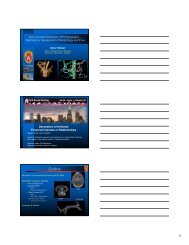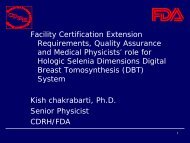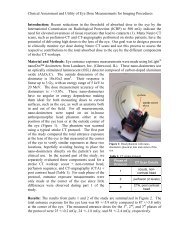ABR Exam diagnostic medical physics
ABR Exam diagnostic medical physics
ABR Exam diagnostic medical physics
You also want an ePaper? Increase the reach of your titles
YUMPU automatically turns print PDFs into web optimized ePapers that Google loves.
Stephanie Leon, MS, D<strong>ABR</strong>, DABSNM<br />
Part 1: General <strong>Exam</strong><br />
Topics covered:<br />
Undergrad material:<br />
Basic <strong>physics</strong> (mechanics, E&M)<br />
Relativity<br />
Simple calculus<br />
Simple circuits<br />
Optics<br />
Statistics<br />
Basic computer science<br />
Most questions require some calculation<br />
Grad school material:<br />
Radioactivity<br />
Radiation interactions<br />
Radiation biology<br />
Radiation detection<br />
Radiation safety<br />
Basic concepts of therapy,<br />
<strong>diagnostic</strong>, and NM <strong>physics</strong><br />
Study Material Recommendations<br />
Your favorite undergrad <strong>physics</strong> textbook, or a review book<br />
such as Schaum’s Outline of College Physics by Hecht et al.<br />
The Essential Physics of Medical Imaging by Bushberg et al.<br />
Radiation Detection and Measurement by Knoll<br />
Radiation Safety in Nuclear Medicine by Lombardi (good<br />
source of practice questions)<br />
Review of Radiologic Physics by Huda and Slone (another<br />
good source of questions)<br />
RAPHEX exams (General section)<br />
Sample questions on <strong>ABR</strong> website<br />
Disclaimers<br />
I am not affiliated with the <strong>ABR</strong>.<br />
I do not write exam questions for the <strong>ABR</strong>.<br />
I am not familiar with the details of current<br />
exam content.<br />
Sample questions presented in this talk are<br />
my own creations and do not include<br />
copyrighted <strong>ABR</strong> material (to the best of my<br />
knowledge).<br />
Lists of recommended study materials are<br />
suggestions only, and are not meant to be<br />
all-inclusive!<br />
Sample Questions<br />
If a cannonball is launched with a velocity of 30 m/s and an angle of<br />
50 degrees, what is its range?<br />
A futuristic spaceship has an observed length of 100 m when<br />
stationary but an observed length of 20 m when travelling at full<br />
speed. If a clock on the spaceship indicates that the ship travelled<br />
at full speed for 1 hour, how long was the trip for an observer<br />
watching from earth?<br />
An image file is 4096x3420 pixels with a 14-bit gray scale. How<br />
many of these images can be stored in a 1 TB hard drive?<br />
What interaction is most likely for a 2 MeV photon in soft tissue?<br />
If a 100 keV photon undergoes Compton scattering and changes<br />
direction by 53 degrees, how much kinetic energy is transferred to<br />
the electron?<br />
Tips<br />
Know common constants like speed of light, gravity,<br />
rest mass of an electron, etc.<br />
Less commonly-used constants will be given to you.<br />
Equations need to be memorized.<br />
Know the difference between radiation units and be<br />
able to convert quickly (R, Gy, rad, Sv, rem, Ci, Bq).<br />
Know other common conversions (ft/m, o F/ o C,<br />
Gauss/Tesla, etc).<br />
Pay attention to the units used in each question and<br />
the units requested for the answer.<br />
Practice using the Windows calculator!<br />
Conserve time – if a question is taking you longer<br />
than 1-2 minutes, flag it and move on.<br />
3/15/2012<br />
1
Part 1: Clinical <strong>Exam</strong><br />
Topics covered:<br />
General anatomy & physiology<br />
Radiation biology<br />
Fetal effects<br />
Cancers<br />
Imaging exams appropriate for specified<br />
anatomy or conditions<br />
Recognition of anatomy on clinical images (CT,<br />
MRI, x-ray, US)<br />
Study Material Recommendations<br />
An A&P review book such as Schaum’s Outline of<br />
Human Anatomy and Physiology by Alcamo and<br />
Van De Graaff<br />
A book on radiological anatomy<br />
Radiobiology for the Radiologist by Hall and<br />
Giaccia<br />
The Essential Physics of Medical Imaging by<br />
Bushberg et al. (Rad bio chapter)<br />
Part 2: Written Specialty <strong>Exam</strong><br />
Physics, QC testing, typical<br />
doses, and artifacts for all<br />
modalities:<br />
Radiography (CR, DR, and film)<br />
Fluoroscopy (Flat panel and II)<br />
CT<br />
MRI<br />
US (incl. Doppler)<br />
Mammography and stereotactic<br />
breast biopsy<br />
Topics covered:<br />
Shielding<br />
Radiation protection<br />
Workstation QC<br />
Image quality measures<br />
Image processing<br />
Dose calculations (skin dose,<br />
fetal dose, effective dose)<br />
Biological effects<br />
Basic radiation <strong>physics</strong><br />
Questions are still calculation-heavy, but not as much as Part 1<br />
Sample Questions<br />
Where is the internal iliac artery?<br />
What imaging exam is capable of providing the<br />
best contrast between white and gray matter in the<br />
brain?<br />
A fetus is exposed to 2 Gy of x-ray radiation 30<br />
days after conception. If a biological effect is seen,<br />
what effect is most likely?<br />
Tips<br />
Memorization, memorization, memorization.<br />
You are not in <strong>medical</strong> school. Don’t focus on minutiae.<br />
A&P questions are not restricted to items “obviously” related<br />
to radiology or radiation oncology.<br />
Study radiological anatomy for both planar and crosssectional<br />
images. Focus on major structures such as organs,<br />
bones, and large vessels.<br />
You will not know every imaging exam used for every<br />
condition. Have an idea about the strengths and weaknesses<br />
of different modalities so you can make an educated guess.<br />
Sample Questions<br />
What fraction of the longitudinal relaxation has<br />
recovered after 1000 ms if T1=2400 ms?<br />
For screen-film mammography, what is the minimum<br />
optical density allowed for the ACR phantom<br />
background?<br />
What would be the effect of multiplying an image in<br />
K-space with a Gaussian filter?<br />
What is the calculated blood velocity using a 5 MHz<br />
transducer if the Doppler angle is 45 o and the<br />
frequency shift is 2 kHz?<br />
3/15/2012<br />
2
Study Material Recommendations<br />
The Essential Physics of Medical Imaging by Bushberg<br />
et al.<br />
Review of Radiologic Physics by Huda and Slone<br />
NCRP Report 147<br />
AAPM TG-18 Report: Assessment of Display<br />
Performance for Medical Imaging Systems<br />
ACR testing manuals<br />
AAPM/RSNA Physics Tutorials for Residents (in<br />
Radiographics)<br />
RAPHEX exams<br />
Sample questions on <strong>ABR</strong> website<br />
Diagnostic Ultrasound: Physics and Equipment by<br />
Hoskins<br />
MRI from Picture to Proton by McRobbie<br />
Part 3: Oral Specialty <strong>Exam</strong><br />
Physics, QC testing, typical<br />
doses, and artifacts for all<br />
modalities:<br />
Radiography (CR, DR, and film)<br />
Fluoroscopy (Flat panel and II)<br />
CT<br />
MRI<br />
US (incl. Doppler)<br />
Mammography and stereotactic<br />
breast biopsy<br />
Topics covered:<br />
Shielding<br />
Radiation protection<br />
Workstation QC<br />
Image quality measures<br />
Image processing<br />
Dose calculations (skin dose,<br />
fetal dose, effective dose)<br />
Biological effects<br />
Basic radiation <strong>physics</strong><br />
Few if any calculations. Be able to answer questions and have an<br />
intelligent conversation about these topics.<br />
Study Material Recommendations<br />
The Essential Physics of Medical Imaging by Bushberg et al.<br />
NCRP Report 147<br />
AAPM TG-18 Report: Assessment of Display Performance for<br />
Medical Imaging Systems<br />
AAPM TG-10 Report: Acceptance Testing/QC of PSP Imaging<br />
Systems<br />
AAPM TG-23 Report: The Measurement, Reporting, and<br />
Management of Radiation Dose in CT<br />
ACR testing manuals<br />
AAPM/RSNA Physics Tutorials for Residents (in Radiographics)<br />
Review of Radiologic Physics by Huda and Slone<br />
Diagnostic Ultrasound: Physics and Equipment by Hoskins<br />
MRI from Picture to Proton by McRobbie<br />
A<br />
B<br />
Tips<br />
Memorize equations.<br />
Focus mostly on current technology, but do not<br />
completely neglect older technologies such as film<br />
and image intensifiers.<br />
Do not worry about state-of-the-art or very<br />
specialized technologies or techniques.<br />
Brush up on the Part 1 material related to radiation<br />
<strong>physics</strong>, radiation biology, etc.<br />
If you are not familiar with ACR or TG-18 testing,<br />
study the manuals.<br />
Sample Question<br />
What test is being performed on<br />
the unit in Figure A? What is the<br />
purpose of this test?<br />
What other tests would you<br />
perform on this type of unit?<br />
How would a stereotactic biopsy<br />
unit differ in design from the unit<br />
in Figure A?<br />
The image in Figure B is from a<br />
stereotactic biopsy unit. What is<br />
the artifact shown? How could it<br />
be corrected?<br />
Is it possible for a similar artifact<br />
to occur on the unit in Figure A?<br />
More Study Recommendations<br />
As you are out testing equipment:<br />
Imagine you are teaching what you are doing to a new<br />
grad student. What tests are performed? How and why do<br />
you do them? What are the passing criteria? What are the<br />
limitations of your test equipment?<br />
Describe the unit to yourself. Ask yourself questions about<br />
it and imagine where they might lead. (Ex: What type of<br />
detector does it have? How does that type of detector<br />
work? What artifacts might you expect to see?)<br />
Describe the typical use of the unit. What types of studies<br />
is it used for? What are common techniques, doses, and<br />
image processing? What safety precautions are used with<br />
this equipment?<br />
3/15/2012<br />
3
More Study Recommendations<br />
Make sure you are not too dependent on<br />
technology:<br />
If you normally use a commercial program to do shielding<br />
calculations, can you do them by hand?<br />
When testing equipment, would you be completely lost<br />
without your laptop and protocols?<br />
If you have a detector that gives a one-shot HVL, do you<br />
remember how to test HVL with Al?<br />
Go through Bushberg and other relevant books.<br />
Study the figures. Would you recognize them out<br />
of context, without figure captions? Pick random<br />
figures and practice explaining them.<br />
Tips<br />
Keep your studying focused on understanding concepts and<br />
clinical applications. Do not spend time memorizing equations.<br />
If you do not do a certain type of work, try to shadow someone<br />
who does (if not a physicist, then at least a tech). If possible, set<br />
up “labs” for yourself.<br />
You should know clinically-relevant information such as<br />
occupancy factors, dose limits, common doses, QC tests<br />
performed, typical results of those tests, etc.<br />
If you don’t know the answer to something, say so. Explain<br />
where you would find the information. Don’t make stuff up.<br />
Be familiar with common phantoms.<br />
Be familiar with common artifacts and troubleshooting<br />
techniques.<br />
Know the names of important NCRP and AAPM documents.<br />
Dress professionally (most wear suits).<br />
I found that attending a mock oral exam was very helpful.<br />
3/15/2012<br />
4




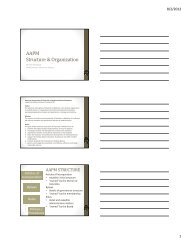
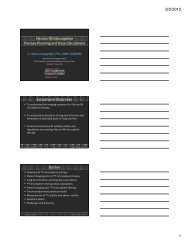


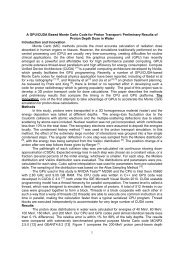
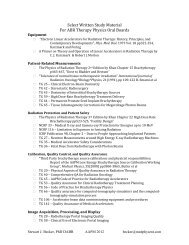
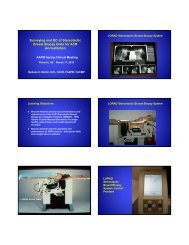
![SBRT&StereoscopicIGRT_2012 [Compatibility Mode]](https://img.yumpu.com/16889220/1/184x260/sbrtstereoscopicigrt-2012-compatibility-mode.jpg?quality=85)

